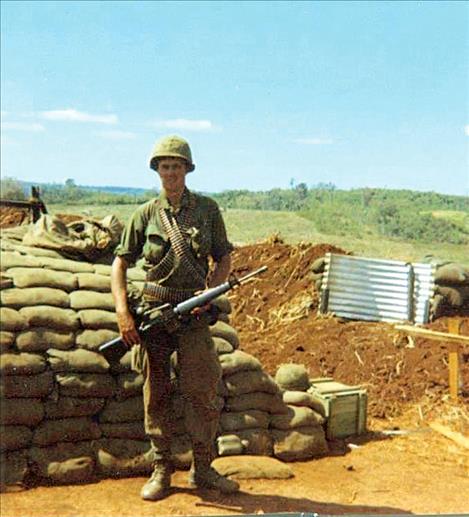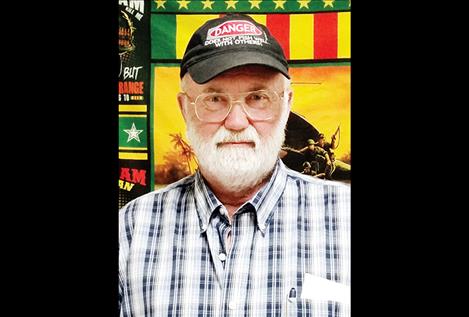Veteran Spotlight
Hey savvy news reader! Thanks for choosing local.
You are now reading
1 of 3 free articles.
On June 10, 1969, John Noel was on a bus to Butte, Montana, courtesy of an invitation letter from the President. He was inducted into the Army on June 11 and immediately shipped out by bus to Fort Ord, California. John looked around when he got off the bus and thought, “Wow, this isn’t going to be a good time.”
On the second day, he got his head shaved, military-issued clothes and shots and was loaded into an open-top cattle truck. When the truck stopped, John saw huge, meaty hands come over the side of the truck and someone shouted, “Get of my ******* truck!” This was when he met Sergeant Ellis, who was a loud, in-your-face, assistant drill sergeant. Again, John thought, “I ain’t gonna like this.”
He remembers working hard in basic training and nearly starving. They had a short time to eat, then, “Time’s up.” Scrape any food left into the garbage can, wash the tray and get out the door – no conversation or socialization. John and a buddy would occasionally sneak out at night, raid the garbage cans and share the good stuff with the rest of the guys back in the barracks. The barracks were located in old World War II wooden buildings. There was no smoking allowed and someone had to stand fire watch.
Once, John and a buddy, from Charlo, Montana, snuck out of the company area, which they were never supposed to leave and raided an ice cream truck parked by the commissary. They picked the lock and helped themselves to a box of ice cream bars, but back at the barracks, they nearly got caught and John hid the loot with him in his bunk. The guys had soft ice cream that night. They buried the “evidence” under the barracks.
John did both basic training and Advanced Infantry Training at Fort Ord in about six months. In AIT, he was assigned at MOS of 11 Bravo (infantry). It wasn’t much better than basic, but at least he could leave the company area. He spent time learning about weapons, shooting, running and digging holes. At the end of his training, he went home for four weeks and then was shipped out to Vietnam.
John was flown to Bien Hoa, Vietnam. When the plane door opened, John remembers going from air conditioned comfort to a big sauna that smelled like a hot sewer. It was so hot and humid that he didn’t sleep for the first four nights. His next stop was at Tay Nihn basecamp and then on to LZ Grant (landing zone.) Shortly after Thanksgiving Day, they tore down the camp and moved on. There were no tents, and they slept on the ground with a poncho liner for a blanket. Sometimes, they had mosquito nets. In monsoon season, they got air mattresses.
Occasionally, two guys would put their ponchos together to make a tent. John remembers catching rainwater running off the poncho at night to refill his canteens. Sometimes, they didn’t know what month it was, much less what day. They would spend about four weeks in the bush, and then, they went to the landing zone for a three-day rest. While in the bush, they would be resupplied by chopper with food, water and ammo. They were never in a town. Water was sometimes brought in recycled artillery powder tubes. If they weren’t well cleaned out, the guys got “gunpowder water” and in that case their next move included lots of stops in the bush.
For about three days a month, they’d be back at the landing zone and get hot chow and a shower. Showers were taken under a canvas five-gallon bucket hanging from three poles.
John and some buddies snuck a ride in a supply truck to the Air Force base where there was air-conditioning and better food and they got caught. Air-conditioning wasn’t allowed for Army guys.
If John was in a hot-combat area when they stopped to sit down, they would space themselves out with every other soldier facing the opposite direction to keep watch. The life expectancy of the point man was about 30 days. For a while, he volunteered to be point man. There were so many new guys who had never been off asphalt, and he thought, with his hunting and tracking experience, that it was safer for him to be the point man. After six months or so, his company commander moved him to the command post and made him the Company Commander’s Radio Telephone Operator. He was more useful for packing equipment and not being out front.
The United States military wasn’t supposed to cross into Cambodia so that’s where the North Vietnamese stored a lot of their supplies, ammunition, etc. The 1st Cav was one of the first to go into Cambodia. John’s company of about 150 men were sent to search out and destroy these stockpiles. They were dropped in “Charlie Alpha” (combat assault). There were no replacments for them because they weren’t supposed to be there.
Once they were attacked by surprise. After hitting the ground, John remembers bullets all around and wanting to unbutton his shirt to get closer to the ground. Only about 50 of the men came back from Cambodia.
John got two air medals and each one represented 30 combat assault drops. He preferred riding skids, the runners on the helicopters, so he could be one of the first ones out when they got to their landing zone. Sometimes, they were dropped into an area to build a landing zone. What they needed to build it was dropped with them. He spent a lot of time filling sandbags.
One time, his squad was judged to be the hardest working when building a landing zone, so they got a one-day leave to go to Saigon, South Vietnam, to see the Bob Hope show. John thinks it was probably a good show, but he remembers the girls with Bob the most.
His chopper was shot down on the way back. When he heard a chaplain who was on board say, “Oh, s___!” John knew they were really in trouble. The chopper had an auto-rotate mechanism that operated like a pinwheel to buffer a landing. It was a tricky maneuver but the pilot got them down, roughly but safely.
After John was in the country for about 11 months, he finally put in for a week of rest and relaxation in Sydney, Australia. He waited until the end of his tour because he thought it might be hard to go back to the bush. In October of 1970, John left Saigon for California. At the San Francisco, California, airport, where they didn’t like you if you were in uniform, John (being one of the last to fly out) says he took a lot of crude treatment and finally had enough. He said there might still be a guy back there with “his head stuck in a toilet.”
John spent about a month at home and then had to go back on duty for his last six months. When asked where he wanted to go, he said either Fort Lewis, Washington, or Fort Carson, Colorado. The Army sent him to Germany.
John landed in Frankfurt, Germany and then was bused to Heilbronn. He was assigned to the 23rd Ordnance Company. Vietnam returnees were put in a security platoon to guard ammo bunkers. This involved security and picking up cigarette butts. During that winter, he had to play “war games,” which didn’t make much sense to him since he’d done the real thing. A visiting general asked John if he would consider a re-enlistment. John said, “no one in his right mind would re-up in this man’s army. I am not going to another war I can’t walk to.”
He volunteered for security duty out of Badenerhof Kaserne in Heilbronn. He would go to Siegelsbach for 24 hours to guard ammo bunkers, and then have three days off back at Kaserne. John remembers the area as being timbered with deer, a lot like back home. Not being much of a tourist, John didn’t do a lot of traveling around. One of the guys bought a car and they spent time traveling, but, mostly, he was ready to go home.
John feels sorry for WWI and II guys who were in for the duration. At least he had a date to come home. Vietnam was so political: “the North Vietnamese could have been whupped in a week.” If he had it to do again, he might enlist in the Air Force. They had better accommodations.
Was there anything good about Vietnam? Yes, the Freedom Bird that flew him home. The bad part was, “Everything there bit, stung, had thorns or shot at you.” The mosquito repellant he was issued caused his skin to feel hot, like a sunburn, and would melt your fingerprint into a plastic spoon.
While monitoring the radio one night, he got three tarantula bites. The bites swelled to the size of golf balls. The medics were worried but couldn’t medevac him out because of the rain. Once he had a little green viper crawling up his pack toward his neck. A guy said, “Christmas (John’s nickname), don’t move.” He distracted it. John dumped his pack and jumped away. He beat the poor thing to death with a shovel. He also had a nest of “termites” (army ants) in his pocket when he woke up one morning.
John thinks the military can provide good training, especially for young people who think their cellphone is their life. He would hate to see anyone have to go into combat, but the service would be good to learn discipline, respect and to be dependable.
Thank you for your service, John.

















